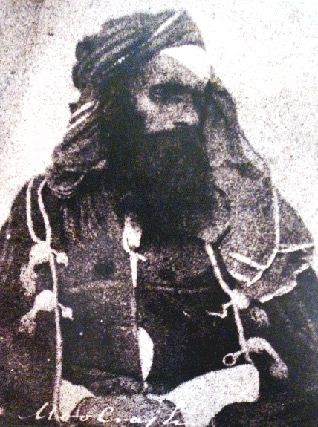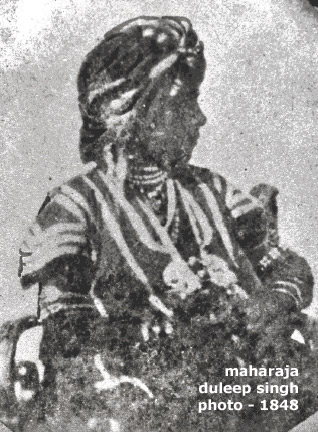Art
The First Photo Portraiture of Sikhs & Punjabis
AMARJIT SINGH CHANDAN
The etymology of the word 'portrait' refers to the 16th century French word meaning 'to portray, to depict in a work of art.'
The Oxford English Dictionary gives the meaning as: an artistic representation of a person depicting only the face or head and shoulders.
The first ever daguerreotype – photo – portrait of a Sikh or Punjabi was taken in Lahore in early 1848 by Dr John McCosh, a surgeon in the army of the British East India Company. The subject was Diwan Mool Raj, the Sikh Governor of Multan, taken captive and condemned to death by the British.
He was the last flicker and certainly an unsung hero of the sovereign Sikh state of the Punjab. He, along with Bhai Maharaj Singh, had led the stiff resistance against the British army at the battle of Multan.
Another historically significant portrait by McCosh was of Maharaja Duleep Singh, then aged ten.
The definition of the word portrait as an artistic representation of a prisoner taken by an invading army cannot be strictly applied, especially to the one of Diwan Mool Raj. The McCosh collection in the National Army Museum in London, England, consists of 310 surviving photographs of British officers and their families.
His portfolio also includes ten images of Punjabi subjects: apart from Duleep Singh, some Sikh Chieftains, granthis, and the samadhi (incorrectly listed as a tomb) of Maharaja Ranjit Singh.
The Diwan portrait was first published in the Illustrated London News (1 September, 1849) with the following caption:
Moolraj is seen here wearing a similar dress to that worn on the day of his surrender where he was gorgeously attired in silks and splendid arms; in figure he appeared not to exceed the middle height, and, though powerfully, was elegantly formed; his dark, keen and piercing eyes seemed to take in whatever was within their range with a rapid but comprehensive glance.
The Diwan was perhaps the first Sikh or Punjabi to face the trunk-size camera and it took a while for those colonised to get accustomed to the three-legged and one-eyed monster coming all the way from vilãyat. Nevertheless the Diwan, in his defiant posture, shows dignity in defeat and a deep sense of disgust towards his captors.
He was to die a year later at Buxar in August 1850 from an illness contracted as he was being transported to Benares. He was 37 then.
September 3, 2012
Conversation about this article
1: Sandeep Singh Brar (Canada), September 04, 2012, 12:00 PM.
Those are lovely pictures and they both share a common thread, that both Diwan Mulraj and Duleep Singh were tragic victims of circumstances beyond their control. Although Duleep Singh's story is well known, that of Diwan Mulraj is not, especially the origins of the revolt that led to what is known as the Second Anglo-Sikh War. Diwan Mulraj was a Hindu Khatri who came from a very powerful Hindu family. His father, the Hindu chieftan Dewan Sawan Mal Chopra, had been appointed governor of Multan by Maharaja Ranjit Singh and during his lifetime had governed over a vast territory of southern Punjab that included the provinces of Multan, Jhang and Derajat with near absolute authority. Diwan Mulraj succeeded his father as the Nizam of Multan following his death in 1844. This was a period of great instability in the Lahore Kingdom following the death of Maharaja Ranjit Singh. Diwan Mulraj did not participate in the First Anglo-Sikh War or help the Sikhs fight the British. He decided to watch how things unfolded instead and see who would win. In the post-Ranjit Singh era the Lahore Kingdom fearing the possibility of the rise of an autonomous Hindu Kingdom in South Punjab in the territories governed by Mulraj, imposed a heavy succession fee on his becoming the Governor (under Maharaja Hira Singh). Under successive Sikh rulers finally culminating in the puppet Sikh government in Lahore led by the child Maharaja Duleep Singh and his Council of Regency and controlled by the British and Henry Lawrence, the British Resident, Mulraj's judicial and commercial authority was significantly reduced, taxation was increased and one-third of his territory including Jhang was taken away from him. Mulraj protested these changes at Lahore unsuccessfully before tendering his resignation in December 1847. On April 18, 1848, a meeting took place at Multan fort with Mulraj present in which the newly designated Governor appointed by the Lahore Kingdom, Kahan Singh Man, witnessed by two British officers officially took charge from Mulraj. A number of soldiers belonging to Mulraj's government were dismissed from their posts; this is when things started to go wrong. This group of primarily Hindu and Sikh soldiers (the Pathan soldiers in Mulraj's army remained indifferent and eventually joined the British side) were resentful that Mulraj was being pushed out of his rule by the new regime and that they would no longer enjoy their previous authority or political and economic favours under the new Governor. These solders revolted, attacked and killed the two British soldiers; meanwhile Mulraj shocked at the incident locked himself up in his residence. The soldiers rising in revolt against the English gathered around Mulraj at his residence. In the beginning Mulraj tried to avoid them but they eventually forced him reluctantly to lead their revolt. The rest is history as this minor revolt was used by other interests including the British to annex the Lahore Kingdom and Rani Jindan to destroy the Khalsa Army which she viewed as a threat to her son's precarious rule. The war would see the death of thousands of Sikhs and the heroic battles and defeats of great Sikh warriors and chieftains like Sardar Chattar Singh Attariwala, the Governor of Hazra and his son Sher Singh and the religious saint turned soldier, Bhai Maharaj Singh.





